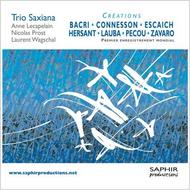
Trio Saxiana: Creations
Despatch Information
This despatch estimate is based on information from both our own stock and the UK supplier's stock.
If ordering multiple items, we will aim to send everything together so the longest despatch estimate will apply to the complete order.
If you would rather receive certain items more quickly, please place them on a separate order.
If any unexpected delays occur, we will keep you informed of progress via email and not allow other items on the order to be held up.
If you would prefer to receive everything together regardless of any delay, please let us know via email.
Pre-orders will be despatched as close as possible to the release date.
Label: Saphir Productions
Cat No: LVC1123
Format: CD
Number of Discs: 1
Genre: Chamber
Release Date: 1st October 2012
Contents
Works
American letters, op.35 bis (2 saxophones & piano)Sonatina lapidaria, op.108 no.2 (saxophone and piano)
Sonatina lirica, op.108 no.1 (saxophone and piano)
Disco toccata (2 saxophones)
Phantasia antiqua (2 saxophones & piano)
Chant hassidique (solo saxophone)
Porgy stride (2 saxophones & piano)
Nanook trio
Perroquets d'azur (solo saxophone)
Rush (solo saxophone)
Artists
Trio SaxianaWorks
American letters, op.35 bis (2 saxophones & piano)Sonatina lapidaria, op.108 no.2 (saxophone and piano)
Sonatina lirica, op.108 no.1 (saxophone and piano)
Disco toccata (2 saxophones)
Phantasia antiqua (2 saxophones & piano)
Chant hassidique (solo saxophone)
Porgy stride (2 saxophones & piano)
Nanook trio
Perroquets d'azur (solo saxophone)
Rush (solo saxophone)
Artists
Trio SaxianaAbout
Regarding chamber music, it is doubtless the quartet form that has given rise to the most interesting pieces, as attest, in particular, the scores by Glazunov, Pierné, Schmitt, Xenakis, Glass and the considerable discography that illustrates them.
In addition to the repertoire for saxophone and piano - fairly extensive but quite varying in quality (Koechlin, Hindemith, Carter, Sancan, Sauguet, Denisov), we can also point out interesting pieces by Caplet, Villa-Lobos, Jean Cras, Nono and Wolpe, using the saxophone in original combinations with other instruments. In the final analysis, many attempts are unfortunately too anecdotal to give the saxophone a real literature, whereas in jazz bands, it quickly gained extraordinary and lasting success.
When, in 2000, they formed the Saxiana Trio, Anne Lecapelain, Nicolas Prost and Laurent Wagschal were able to come up with only a very small number of original works for two saxophones and piano. We can mention, in particular, the first piece in history written for this formation, in 1858: the Duo concertant by Jean-Baptiste Singelée (1812-1875).
Saxiana initially built up a repertoire by producing transcriptions on the basis that they would never play works that predated the birth of the saxophone and favouring those composers who used or defended the instrument. Thus, these are essentially 20th-century works, and the musicians most often play in the configuration combining soprano and tenor saxophones with piano, although Nicolas Prost and Anne Lecapelin also able, depending on the piece, to use the alto and baritone.
This product has now been deleted. Information is for reference only.
Error on this page? Let us know here
Need more information on this product? Click here